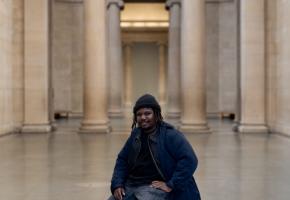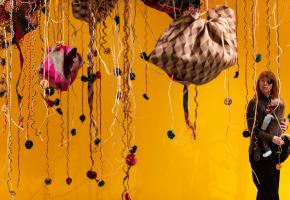In the first ever UK solo exhibition of the late Colombian artist, Caballero’s subject matter - the male nude - encapsulates the oppositional contextual influences of his life and practice. The artist’s conservative Catholic upbringing in Colombia during La Violencia exists alongside his adulthood spent largely in Paris as one of very few openly queer Latin American artists before and during the AIDS epidemic.
Caballero’s figures experience pain, pleasure or a combination of the two. Violence and eroticism merge and overlap. The bodies are imbued with Renaissance motifs and Christian theistic imagery, whilst also reflecting his celebration of contemporary queer male sexuality. The visual allusion to Christ - through bodies that represent himself, his lovers and his audience - communicates the divine nature of human sexuality.

Courtesy of Cecilia Brunson Projects, photography by Eva Herzog
The Colombian artist’s work explores contradiction, and invites his audience into a deeper understanding of the worlds that exist in the intersections of seemingly incompatible identities. Produced in a creative landscape of abstractism, absurdism and neo-expressionism in mid-late 20th century Paris, his art is extremely technical, influenced by his formal artistic education at both the Universidad de los Andes and the Académie de la Grande Chaumière. However, this precision of shape - the exactitude of the line and loyalty to creating realistic bodies - is juxtaposed with the intimacy of the subject.
At Cecilia Brunson Projects, a gallery dedicated to promoting “overlooked historical and contemporary Latin American artists”, Caballero is showcased in all his tenderness and glory. This particular collection focuses on five works from 1979 to 1982, offering a concise insight into the series of contradictions that pervades the artist’s oeuvre.

Courtesy of Cecilia Brunson Projects, photography by Eva Herzog
Curated by Daniel Malarkey, the exhibition makes powerful use of text and space to bring an artist relatively unknown in Britain - despite his celebrity status in Colombia - into a place of clarity and understanding. Malarkey’s introductory material, using text from Bella Keyosan’s essay written specifically for the exhibition, is incredibly accessible - the viewer, no matter their prior knowledge of the artist, is well-equipped to appreciate his striking works after the brief and effective background information available upon entry. There is nothing pretentious or overcomplicated, and this is to the exhibition’s great credit.
A dedication to simplicity seems to underpin many of the creative choices in the building of this collection. The pieces exhibited are all greyscale, despite this representing only a section of the artists’ output. Malarkey made the decision to remove the distraction of colour, allowing the viewer to “focus on form and composition and content”.
Similarly, whilst Caballero worked across various media, this exhibition hones in on “the immediacy of drawing” (Malarkey). And perhaps most boldly, Malarkey allows each piece to stand on its own in the space, inherently recognising that Caballero’s mode of communication of choice is not words. The starkness of this decision, combined with the starkness of the room itself, encourages the viewer to engage with each canvas intimately.

The bodies on the canvases are lifesize or just slightly scaled up, and the physical imposition of the pieces is heightened by the bareness of the space. Malarkey describes how “these pieces have a real power and magnetism. They hit your stomach. We’re showing impactful art here.” His decisions demonstrate a well-placed trust in the power of each canvas to speak urgently and personally to each viewer. However, perhaps even more striking than this is that, alongside a trust in the works themselves, Malarkey’s curation implies a trust in the viewer: that if he allows these works to speak, they will allow themselves to listen.
In spotlighting the creations of this under-exhibited artist, Cecilia Brunson Projects pays tribute to Caballero’s particular significance. As one of very few openly queer Latin American artists of his time, he offers an insight into a corner of art history that remains largely unexplored. As we experience an increased focus on modern queer art and the body as artistic subject, it is crucial to celebrate the predecessors who have paved the way, and who demonstrate the unwavering presence of queer artists throughout history. Having died of AIDS at only 51, Caballero reminds us of the generations of queer people whose life and work was cut short by an epidemic of silence and stigma.

Courtesy of Cecilia Brunson Projects, photography by Eva Herzog
Quoting from the 1991 Edward Lucie-Smith essay on the artist, Malarkey captures the excitement and potency of Caballero’s work in his exhibition title: A Deliberate Defiance. After having first learnt about Caballero via this essay, “that felt emotionally strong for the show” (Malarkey). Defiance is precisely the word - Caballero’s canvases are unapologetic and unflinching. They bear their souls, and demand that, at least to themselves, their viewers do the same.
Ultimately, it is the simultaneous timelessness and timeliness of this exhibition that makes it exceptional. Caballero’s work incorporates long-standing artistic and religious tradition, and speaks to enduring themes of sex, violence, eroticism and pain. Yet at the same time, it is dynamic, current and ephemeral. Caballero’s themes do not limit him to relevance in a single place and time, but surpass temporal boundaries by representing universal human emotion and experience. “His work is fresh. His work is now. It is hugely edgy, and hugely daring.” (Malarkey).
Luis Caballero: A Deliberate Defiance is showing at Cecilia Brunson Projects until the 9th of February 2024.



















